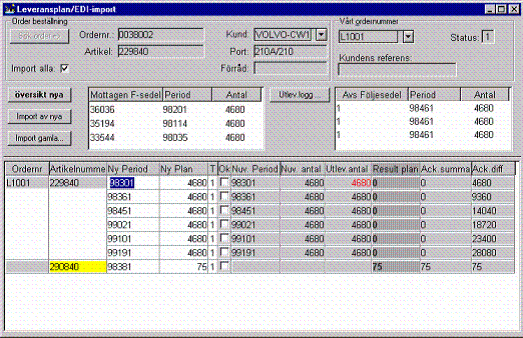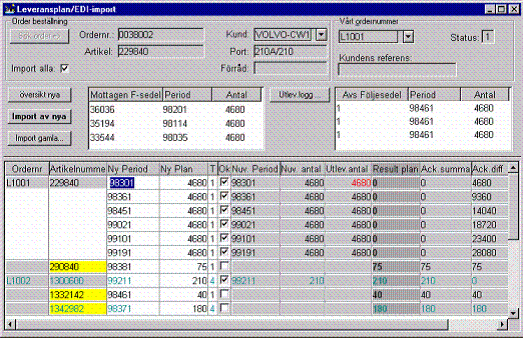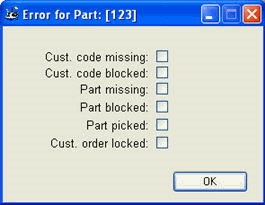
When using the Import EDI Delivery Schedules procedure, you can both create delivery schedules manually or import delivery schedules that have been received via EDI. We will only discuss the EDI import at this point.
The delivery schedules can be received via EDI in two different formats: DELFOR or CALOFF. The latter, CALOFF, is a special variation created for Volvo that only displays a limited period of time. Once a CALOFF is loaded into the database, the earlier DELFOR is replaced with the CALOFF up to a certain date that is indicated in the message.
The order date for the delivery schedule/customer order will change during each new import. The order date has minor importance when it comes to delivery schedules, as their order inflow must be managed separately. By always resetting the order date during a new import, the shortage part lists can be limited to only include the delivery schedules that have been imported a certain date, making it possible to concentrate on the most important items first.
Overview of New Delivery Schedules

Overview of new schedules in the Import EDI Delivery Schedules procedure.
You can start by loading a summary of new orders via the Overview new button, in order to obtain information about what needs to be updated in the database so that the import can be properly executed. Most users won't need to use this feature once they start working with delivery schedules regularly. In the overview, the Save function has been blocked in the Window functions.
Importing New Delivery Schedules

New imported schedules in the Import EDI Delivery Schedules procedure.
When you import new schedules using the Import New button, the order rows that are incorrect are highlighted in yellow. You can see the reasons or causes by right-clicking on the order row and selecting Test Schedule from the menu. A check of the customer code and part number now takes place. A part or customer may be updated, and the row can thereafter be checked once again using the right mouse button. If the row is correct, the yellow highlight will disappear.

The Test schedule feature used to discover incorrect values in an order row.
A checkup is also made to make sure that the shipped deliveries have been received by the customer. If this is the case, this is indicated by a green flag under the button Del. log. For each respective order row, any deviations or nonconformities will be indicated in red digits under the heading Del. qty. The row can be approved in spite of the red numbers.
A checkup of the part's lead time is also made. The quantity for a new schedule is compared to the current schedule. If there is any deviation within the lead time that has been entered for the part, the entire New period field will be highlighted in red. This checkup will only take place if there is a difference or deviation compared to the previous schedule. This row can still be approved in spite of the red date: in other words, you accept the delivery time anyway.
You can always check the part’s revision if the you send technical status information, changed order number or other similar information together with the delivery schedule. The check or control will be "soft", i.e. the import will take place in spite of the deviation.
You can search for our order number by entering the customer code, the customer's order number or the part number.
By using the Delivery log button you will see all deliveries that have taken place.
Approving Imports
When you approve or authorize the import by clicking on Save, all the approved rows are registered on the customer order. When the delivery schedule is loaded, all the rows that passed the control as approved are highlighted. The rows that are not approved cannot be highlighted as approved either.
Importing Prior Delivery Schedules
The import of old delivery schedules using the Import prior... button can be used to re-load an old delivery schedule. You select the delivery schedule by entering a date. However, no rows are selected or highlighted as automatically approved.
This procedure can be used when you need to get a quick start of your production and purchase planning for all the approved rows. As these are automatically entered as approved during the import of new schedules, you can immediately approve the list after you have checked the received and sent delivery notes. After this, the rest of your organization can start their work using these parts.
After this an import of prior delivery schedules takes place, and you then select the default, that is today's date. You should then review the yellow rows and correct them, and finally approve them. After clicking Save, these rows will also be included in the order backlog.
See also: